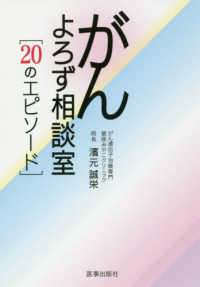Full Description
Teaching Mathematics in Diverse Classrooms for Grades K-4 emphasizes that effective mathematics teaching promotes understanding which provides a sound basis for skill development, all resulting in better learning retention. In a user-friendly format, presenting language consistent with the language used to teach children, the authors of this resource stress that when mathematical information is connected to what students already know about mathematics, it is easier for them to learn and recall. To that end they present the development of mathematical content based on a small number of easy-to-understand and easy-to-teach "big ideas."
Contents
v > About the authors xPreface xi1 Instructional Activities: T he Building Blocks for Effective Instruction 1What Are the Students Learning? 1Developmental Activities 2Exploratory Developmental Activities 2Consolidating Developmental Activities 2Practice Activities 2Think-Time Practice Activities 3Speed-Drill Practice Activities 3Application Activities 3Classroom Applications 3Real-World Problems 4Assessment Activities 4Varied Assessment Methods 4Monitoring and Assessment 4Level of Involvement 6Flexible Use of Activities and Materials 7Exercises and Activities 7References and Related Readings 8Websites 92 Less on Design: C reating Lessons That Meet the Needs of a Diverse Classroom 10Combining Activities into a Lesson 10What Is a Lesson? 10A Traditional Lesson Plan 11The Nature of Standard Traditional Lessons 13Adapting Lessons for Diverse Learning Needs 13A Lesson Adapted for Diverse Learners 16Adapting Another Lesson 19The Planning Process and "Official" Lesson Plans 21contentsA01_TUCK7286_01_SE_FM.indd 5 4/9/12 6:54 PMvi C o n t e n t sThe Planning Process and Teaching Notes 22Exercises and Activities 22References and Related Readings 23Websites 243 Beginnings: M athematics Learning in Early Childhood 25A Common Misconception 25About Young Children 25Teaching Classification 27Pattern Recognition 28Teaching Comparison and Seriation 29Comparison 29Seriation 32Matching and Prenumber Comparisons 33Matching and Prenumber Seriation 33The Beginning of Geometric Concepts: Relative Position 34A Revised Lesson 37Exercises and Activities 40References and Related Readings 40Websites 414 Whole Nu mbers and Nu meration: N aming and Writing Quantity 42Number Sense 42Foundations of Algebra 43Building on What Children Already Know 43The Big Picture 45Development of Numbers and Numeration 45One-Digit Numbers 46Two-Digit Numbers 51Three or More Digits 56Rounding Numbers 59Adapting a Lesson 61Adapting the Lesson for a Diverse Group of Students 61Exercises and Activities 64References and Related Readings 64Websites 645 Adding and Subtracting Whole Nu mbers: C ombining and Separating Quantities 65An Overview of the Development of Computation 65The Meaning of the Operation 65The Basic Facts 66The Algorithm(s) 66A01_TUCK7286_01_SE_FM.indd 6 4/9/12 6:54 PMC o n t e n t s viiTeaching Addition of Whole Numbers 67Developing the Meaning of Addition 67Developing the Easy Basic Addition Facts 69Activities for Exploring Relationships 73Developing the Hard Basic Addition Facts 76Teaching the Addition Algorithm 82Summary of the Developmental Sequence for Addition 85Teaching Subtraction of Whole Numbers 86Developing the Meaning of Subtraction 86Developing the Easy Basic Subtraction Facts 87Developing the Hard Basic Subtraction Facts 90Teaching the Subtraction Algorithm 92Summary of the Developmental Sequence for Subtraction 93Adapting a Lesson 94Teaching Problem Solving Using Addition and Subtraction 96Exercises and Activities 99References and Related Readings 100Websites 1006 Mu ltiplying and Dividing Whole Nu mbers: C ombining Equal-Sized Groups and Separating Quantitiesinto Equal-Sized Groups 101Teaching Multiplication of Whole Numbers 101Developing the Meaning of Multiplication 101Developing the Easy Basic Multiplication Facts 103Developing the Hard Basic Multiplication Facts 107Teaching the Multiplication Algorithm 111Summary of the Developmental Sequence for Multiplication 121Adapting a Multiplication Lesson 121Teaching Division of Whole Numbers 127Developing the Meaning of Division 127Developing the Easy Basic Division Facts 129Developing the Hard Basic Division Facts 131Teaching the Division Algorithm 133Adapting a Division Lesson 144Teaching Problem Solving Using Multiplication and Division 147Exercises and Activities 147References and Related Readings 148Websites 1497 Fractions: Working with Units Smaller Than One 150Defining Fractions 150Three Sides of Fractions 151A01_TUCK7286_01_SE_FM.indd 7 4/9/12 6:54 PMviii C o n t e n t sFractional Units 152Beyond Unit Fractions 154Fractions of a Set 155Equivalent Fractions 156Using the Laboratory Approach 158Comparison of Fractions 159Adding Fractions 161Subtracting Fractions 163Addition and Subtraction Activities 163Improper Fractions and Mixed Numbers 165Adapting a Lesson on Fractions 167Solving Problems Using Fractions 170Exercises and Activities 171References and Related Readings 171Websites 1718 Decimals: Working with Base-Ten Units Smaller Than One 172Decimals 172Place Value for Decimals 174Comparing Decimals 178Adding and Subtracting Decimals 181Adapting a Lesson on Decimals 184Using Decimals to Solve Problems 187Exercises and Activities 187References and Related Readings 188Websites 1889 Measu rement: A ssigning a Number to a Quantity 189Measurement and Geometry 189Defining Measurement 189Measuring Length 190Teaching Area Measurement 199Teaching Volume Measurement 204Measuring Time 208Measuring Weight 210Measuring Temperature 210Measuring Value 210Adapting a Lesson on Volume 211Using Measurement to Solve Problems 214Exercises and Activities 214References and Related Readings 215Websites 215A01_TUCK7286_01_SE_FM.indd 8 4/9/12 6:54 PMC o n t e n t s ix10 Geometry: L earning the Names and Characteristics of Shapes 216The Big Ideas of Elementary School Geometry 216Straightness 217Congruence 217Similarity 218Parallelism 218Perpendicularity 219Symmetry 220Using the Big Ideas to Study Geometric Shapes 220Rectangles in Elementary School 220Circles in Elementary School 225Angles in Elementary School 228Prisms in Elementary School 230Adapting a Geometry Lesson 231Exercises and Activities 235References and Related Readings 236Websites 23611 Data Analysis and Probability: G etting Information from Data and Measuring Likelihood 237Data Analysis and Probability-Two Distinct but Related Areas of Mathematics 237Data Analysis 238Emphasizing the Big Ideas of Data Analysis 238From Exploratory Experiences toward Conceptual Understanding:A Typical K-4 Development of Data Analysis 238Adapting a Data Analysis Lesson 245Using Data Analysis to Solve Problems 250Probability 250Emphasizing the Big Ideas of Probability 250From Exploratory Experiences toward Conceptual Understanding:A Typical K-4 Development of Probability 251Using Probability to Solve Problems 256Exercises and Activities 256References and Related Readings 257Websites 257A ctivities to Take to Your Class room 258I ndex 260A01_TUCK7286_01_SE_FM.indd 9 4/9/12 6:54 PMabout the authorsBenny F. Tucker earned his Ph.D. at the University of Illinois in 1975. He has authored or co-authored more than 50 books, on topics ranging from teaching methods for elementaryschool mathematics to the use of instructional activities in the mathematicsclassroom. He has authored or co-authored more than 20 articles in professional journalsand has made more than 30 presentations at professional conferences.Ann Haltom Singleton is Associate Dean of the School of Education at Union University in Jackson Tennessee. She earned her Ed.D. in Special Education from the Universityof Memphis. Her research areas include leadership development and mathematicsinstruction, especially in inclusive settings. She has contributed to numerous articles andhas made over 30 national presentations. She was recognized as the Union University2003 Faculty of the Year.Terry L. Weaver honed his teaching skills in the Miami-Dade County School System.He received his Ph.D. in Special Education from George Peabody College for Teachersat Vanderbilt University. Dr. Weaver then shared his teaching skills at Carson-NewmanCollege and Union University where he continues to teach. Dr. Weaver has served as anitem writer for and participated in the revalidation of the Praxis II Specialty Area Testin SE (Core Knowledge). He is a co-author of Teaching Mathematics to All Children:Designing and Adapting Instruction to Meet the Needs of Diverse Learners, has presented on differentiated instruction and assessment, universal design, inclusion, and adaptinginstruction for diverse learners, and recently lead the revision of a chapter on mathematicsin Vaughn's and Bos's Strategies for Teaching Students with Learning and BehaviorProblems. xA01_TUCK7286_01_SE_FM.indd 10 4/9/12 6:54 PMxiWhy This Book?The diversity of students in K-4 classrooms is extensive. The children in a typical classroomare diverse in gender, diverse in race and ethnicity, and diverse in religion andculture. They are diverse in ability, diverse in interests, and diverse in preferred learningstyles. And they are diverse in family background, and diverse with respect to resourcesin the home such as books and technology. In the face of such diversity, how can theteacher expect to plan for effective instruction?Although teachers must certainly be aware of student diversity and the need toaccommodate that diversity, it is perhaps more important for K-4 teachers to be aware ofthe ways in which their students are alike. For example, almost universally, children arekinestheticlearners. It is natural for them to be active and move around. They love classroomactivities that allow (even require) them to be energetic and animated. Childrenare also naturally inquisitive. They are interested in what, why, and how. It is the natureof children to be curious about things. They like to talk to one another, to exchangeideas, and to discuss the things that they are experiencing and learning. Children areconcrete learners. They enjoy handling things, seeing how things are related. Theylike to understand.In this text, we provide an approach to the planning and teaching of K-4 mathematicsthat is based on the nature of children. We believe that the teaching suggestions inthis text will help teachers be more effective as they plan and teach mathematics in diverseclassrooms, grades K-4. Structure of the BookThe book begins with two introductory chapters that provide a basic understandingof instructional activities and lesson planning. Then there are nine chapters devoted toteaching the content that most commonly appears in K-4 mathematics textbooks. Wedo not attempt to provide comprehensive coverage of every topic that might appear ina K-4 textbook. Rather, our intent is to emphasize a way of teaching effectively thatwill result in learning, understanding, retention of important concepts and skills, andan ability to apply those concepts and skills to solve problems. Important to that way ofteaching is effective planning. Therefore, we have made planning for effective teachingan important part of this text.preface







